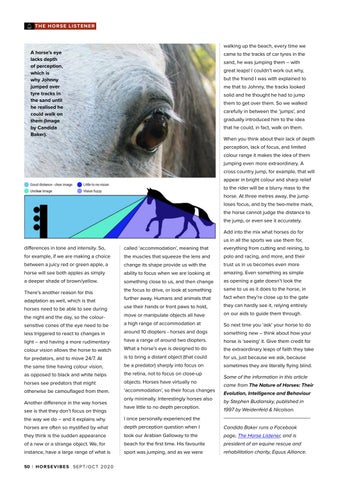THE HORSE LISTENER
walking up the beach, every time we
A horse’s eye lacks depth of perception, which is why Johnny jumped over tyre tracks in the sand until he realised he could walk on them (Image by Candida Baker).
came to the tracks of car tyres in the sand, he was jumping them – with great leaps! I couldn’t work out why, but the friend I was with explained to me that to Johnny, the tracks looked solid and he thought he had to jump them to get over them. So we walked carefully in between the ‘jumps’, and gradually introduced him to the idea that he could, in fact, walk on them. When you think about their lack of depth perception, lack of focus, and limited colour range it makes the idea of them jumping even more extraordinary. A cross country jump, for example, that will appear in bright colour and sharp relief to the rider will be a blurry mass to the horse. At three metres away, the jump loses focus, and by the two-metre mark, the horse cannot judge the distance to the jump, or even see it accurately. Add into the mix what horses do for us in all the sports we use them for,
differences in tone and intensity. So,
called ‘accommodation’, meaning that
everything from cutting and reining, to
for example, if we are making a choice
the muscles that squeeze the lens and
polo and racing, and more, and their
between a juicy red or green apple, a
change its shape provide us with the
trust us in us becomes even more
horse will see both apples as simply
ability to focus when we are looking at
amazing. Even something as simple
a deeper shade of brown/yellow.
something close to us, and then change
as opening a gate doesn’t look the
There’s another reason for this
the focus to drive, or look at something
same to us as it does to the horse, in
further away. Humans and animals that
fact when they’re close up to the gate
adaptation as well, which is that horses need to be able to see during the night and the day, so the coloursensitive cones of the eye need to be less triggered to react to changes in light – and having a more rudimentary colour vision allows the horse to watch for predators, and to move 24/7. At the same time having colour vision, as opposed to black and white helps
use their hands or front paws to hold, move or manipulate objects all have
on our aids to guide them through.
a high range of accommodation at
So next time you ‘ask’ your horse to do
around 10 diopters - horses and dogs have a range of around two diopters.
horse is ‘seeing’ it. Give them credit for the extraordinary leaps of faith they take
is to bring a distant object (that could
for us, just because we ask, because
be a predator) sharply into focus on
sometimes they are literally flying blind.
the retina, not to focus on close-up objects. Horses have virtually no
otherwise be camouflaged from them.
‘accommodation’, so their focus changes
see is that they don’t focus on things
something new – think about how your
What a horse’s eye is designed to do
horses see predators that might Another difference in the way horses
they can hardly see it, relying entirely
only minimally. Interestingly horses also have little to no depth perception.
Some of the information in this article came from The Nature of Horses: Their Evolution, Intelligence and Behaviour by Stephen Budiansky, published in 1997 by Weidenfeld & Nicolson.
the way we do – and it explains why
I once personally experienced the
horses are often so mystified by what
depth perception question when I
Candida Baker runs a Facebook
they think is the sudden appearance
took our Arabian Galloway to the
page, The Horse Listener, and is
of a new or a strange object. We, for
beach for the first time. His favourite
president of an equine rescue and
instance, have a large range of what is
sport was jumping, and as we were
rehabilitation charity, Equus Alliance.
50 | H O R S E V I B E S S E P T / O C T 2 0 2 0

























